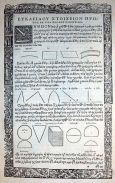 The field of mathematics has a long and fascinating origin. Its foundation is based in logic, which has greatly enhanced its significant development. This invaluable foundation in logic is seen in a work that took place in ancient Greece in the centuries preceding Euclid.
The field of mathematics has a long and fascinating origin. Its foundation is based in logic, which has greatly enhanced its significant development. This invaluable foundation in logic is seen in a work that took place in ancient Greece in the centuries preceding Euclid.
I am currently reading a very interesting commentary on the history of ancient mathematics and Euclid’s Elements written by Proclus, who lived during 412-485 AD. Proclus was the last major Neo-Platonic philosopher of importance before the Neo-Platonic successor of the famous Academy was closed by the Christian emperor Justinian in the 6th century. He wrote many books based on commentaries on Plato’s dialogues, but this commentary on the Elements by Euclid is particularly interesting since it offers a unique account into aspects of Euclid’s life.
Very little is known about the life of Euclid. Despite having more of his writings available than of any other ancient mathematician in history, there is little biographic evidence to draw a good image. In his book, Proclus, informs the reader among other details, that Euclid was living in Alexandria at about 300 B.C. and that he belonged to the persuasion of Plato, at home in his philosophy. That is pretty much all we are aware of.
Euclid (Εὐκλείδης) of Alexandria, is named as the author of Elements, one of the most influential works in the history of mathematics, serving as the main textbook for teaching geometry from the time of its publication. It is astounding to conceptualize that a book written so many years ago by a scientist that we know so very little about, is still relevant today.
Best known for its Geometric results, Elements culminates the construction of five regular solids, known as the Platonic solids. It also covers aspects of number theory such as prime numbers, factorization and greatest common divisor. The Euclidean algorithm, the procedure for finding the greatest common divisor of two numbers, is computationally efficient and is still programmed in software we use today, with just minor modifications.
The Elements have been printed over the centuries in many languages. Starting with the original Greek, The Elements has also been translated in Arabic, Latin, and many other modern languages. Approximately half a century after the Latin edition, the Greek edition appeared with text edited by German theologian and philologist, Simon Grynaeus. This edition featured geometrical diagrams embedded in the text, rather than the margins of earlier editions. This is also the edition that includes Proclus’ commentary on the original work with references to the views of Euclid’s mathematics predecessors and successors.
Collectors of books of science interested in purchasing a scarce edition of The Elements are bound to be disappointed. In fact, the oldest surviving edition held by institutions is a 12th century Latin translation by Adelard of Bath. A 1482 copy of Elementa Geometriae, Venice: Erhard Ratdolt, rebound in full brown calf with toning and light spotting to early and late leaves, was sold by British antiquarian book dealer Peter Harrington for £150,000 recently. Any early Arabic editions have also vanished. It seems that collectors may have as good a chance to locate such a prestigious copy, as digging up a fragment of a leaf of the original Greek manuscript which may still be available at the Oxyrhynchus archaeological site in Egypt.
{ 0 comments… add one now }